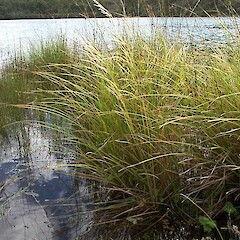Deschampsia cespitosa
Common name
tufted hair-grass, wavy hair-grass
Synonyms
Aira cespitosa L., Aira australis Raoul, Deschampsia penicillata Kirk, D. cespitosa var. Macrantha Hack.
Family
Poaceae
Flora category
Vascular – Native
Endemic taxon
No
Endemic genus
No
Endemic family
No
Structural class
Grasses
NVS code
The National Vegetation Survey (NVS) Databank is a physical archive and electronic databank containing records of over 94,000 vegetation survey plots - including data from over 19,000 permanent plots. NVS maintains a standard set of species code abbreviations that correspond to standard scientific plant names from the Ngä Tipu o Aotearoa - New Zealand Plants database.
DESCAE
Chromosome number
2n = 26
Current conservation status
The conservation status of all known New Zealand vascular plant taxa at the rank of species and below were reassessed in 2017 using the New Zealand Threat Classification System (NZTCS) – more information about this can be found on the NZTCS website. This report includes a statistical summary and brief notes on changes since 2012 and replaces all previous NZTCS lists for vascular plants.
Please note, threat classifications are often suggested by authors when publications fall between NZTCS assessment periods – an interim threat classification status has not been assessed by the NZTCS panel.
- Conservation status of New Zealand indigenous vascular plants, 2017 . 2018. Peter J. de Lange, Jeremy R. Rolfe, John W. Barkla, Shannel P. Courtney, Paul D. Champion, Leon R. Perrie, Sarah M. Beadel, Kerry A. Ford, Ilse Breitwieser, Ines Schönberger, Rowan Hindmarsh-Walls, Peter B. Heenan and Kate Ladley. Department of Conservation. Source: NZTCS and licensed by DOC for reuse under the Creative Commons Attribution 4.0 International licence.
2017 | At Risk – Declining | Qualifiers: DP, PD, SO
Previous conservation statuses
2012 | At Risk – Declining | Qualifiers: CD, SO
2009 | At Risk – Declining | Qualifiers: SO, CD
2004 | Gradual Decline
Distribution
Indigneous. New Zealand: North, South, Stewart and Chatham Islands—generally scarce in the northern third of the South Island and highly threatened on Chatham Island. Otherwise at times (especially in Southland and Fiordland) locally common.
Habitat
Wetlands and lake margins. Coastal to subalpine damp grass or sedge swards near lakes, rivers and swamps. Also found in estuarine margin communities.
Wetland plant indicator status rating
Information derived from the revised national wetland plant list prepared to assist councils in delineating and monitoring wetlands (Clarkson et al., 2021 Manaaki Whenua – Landcare Research Contract Report LC3975 for Hawke’s Bay Regional Council). The national plant list categorises plants by the extent to which they are found in wetlands and not ‘drylands’. The indicator status ratings are OBL (obligate wetland), FACW (facultative wetland), FAC (facultative), FACU (facultative upland), and UPL (obligate upland). If you have suggestions for the Wetland Indicator Status Rating, please contact: [Enable JavaScript to view protected content]
FACW: Facultative Wetland
Usually is a hydrophyte but occasionally found in uplands (non-wetlands).
Detailed description
A stiffly erect green to yellow-green tussock, which stands 20–50 cm tall. The leaves are narrow (1–4 mm wide) and are flat or partly rolled and dull green above and bright green beneath and rough to touch. An attractive grass with blonde flowering heads 1 m or more tall that occur in January. Seed is produced in February.
Manaaki Whenua Online Interactive Key
Similar taxa
Tall fescue (Lolium arundinaceum (Schreb.) Darbysh. subsp. arundinaceum) can look similar when in seed, but this species has a taller seed head and the leaves are much larger and broader than tufted hair-grass. Common UK forms of Deschampsia sold in garden centres, often as impostors for the NZ form, have a chromosome number of 2n=48. The NZ plant is more erect, with a lower vernalisation requirement and a greater susceptibility to stem rust disease (Puccinia graminis).
Flowering
January
Fruiting
February
Life cycle
Florets are wind dispersed (Thorsen et al., 2009).
Propagation technique
Easily grown by the division of whole plants and from fresh seed. Rather hardy, and despite its natural restrcition to wetlands, it will grow in motys soils and moisture regimes.
Threats
Very palatable to farm and feral stock. Grazing and trampling by cattle is the chief cause of decline. Contamination or replacement of NZ forms of Deschampsia with imported forms is also a serious risk.
Etymology
deschampsia: After Deschamps
Where To Buy
New Zealand plants are occasionally sold by some specialist native plant nurseries. However, the majority of D. cespitosa sold by mainline retail nurseries, while this species, are not the New Zealand plant, and appear to be of European origin.
Taxonomic notes
Although New Zealand plants are treated as D. cespitosa, this is in the broad sense. The “species” is cosmopolitan and highly variable throughout its range with respect to morphology, chromosome number and habitat preferences. New Zealand plants are notable because they are highly palatable to introduced browsing mammals, which is of interest because the same “species” in other parts of the world is considered to be a serious pastoral weed, virtually untouched by livestock, deer etc. This suggests a chemical difference, certainly nrDNA ITS sequences and C-values obtained from New Zealand plants do not match that reported from this species from other parts of the world, nor do our plants match horticultural imports now popular in the nursery trade. Thus the situation is not as simple as implied in Edgar & Connor (2000). Further research into the status of our plants is needed.
Attribution
Fact Sheet prepared for NZPCN by P.J. de Lange 1 July 2005. Description modified from Edgar & Connor (2000).
References and further reading
Edgar E, Connor HE. 2000. Flora of New Zealand. Vol. V. Grasses. Christchurch, Manaaki Whenua Press. 650 p.
Thorsen MJ, Dickinson KJM, Seddon PJ. 2009. Seed dispersal systems in the New Zealand flora. Perspectives in Plant Ecology, Evolution and Systematics 11: 285–309.
NZPCN Fact Sheet citation
Please cite as: de Lange, P.J. (Year at time of access): Deschampsia cespitosa Fact Sheet (content continuously updated). New Zealand Plant Conservation Network. https://www.nzpcn.org.nz/flora/species/deschampsia-cespitosa/ (Date website was queried)















